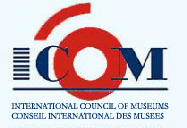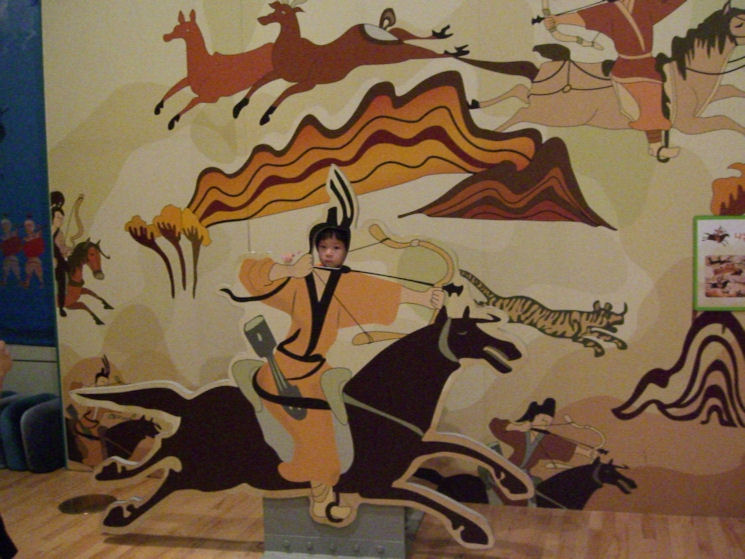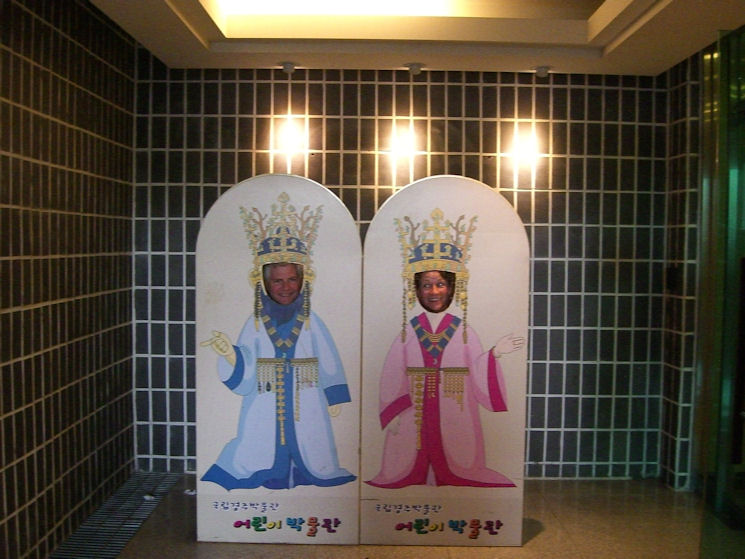 |
|
|||
|
REISERAPPORT
The Wonderful Children’s Museums of Korea ICME 2009 Seoul 19.10. - 24.10 The National Museum of Korea The Children’s Museum at the National Museum is located in a separate wing of the museum, isolating the overwhelming sound of children playing and laughing, it is a separate museum within the museum. The exhibition takes you through different themes; “houses of the past”, with little models you can enter, and complicated Korean roofing tiles you can assemble, and “food and agriculture”, with different farming tools. The “weapons and war” section features a large fort you can climb, and a full set of armour you can try on. Finally, the “music” section features different instruments which, according to the label; “people in the past used when they were both happy and sad.” There is also a separate display on archaeology, and all the themes feature large 3D puzzles. Next to the exhibition is a little library space with children’s books. Here you find even more models, puzzles and arts and crafts. Being a museums educator myself, involved in arranging family Sundays, this children’s museum made me quite envious. We visited the museum on a Sunday, which seems to be the international “Museum family day”. As we came out of the museum for a quick coffee break, the whole front yard had been filled up with a large marquee-tent, offering a range of really advanced arts-and-crafts projects for the whole family. You paid a small fee in each tent, and they gave you your little lamp or piece of fabric, and showed you what to do. All in all, I was very impressed with the family-friendliness! |
 A young warrior on horseback. Photo: Tone C. S. Karlgård |
|
National Folk Museum of Korea The main conference venue was the National Folk Museum of Korea. Here as well they had a separate Children’s Museum, in a separate part of the Museum grounds. The main exhibition was a little difficult to understand at the time (all texts are in Korean), but after checking the website I learned that the exhibition tells the story of a young girl who “once upon a time” sacrificed herself to the great ocean, in order to help her blind father. After some dramatic events, the girl marries the king and her father can see again! The exhibition shows us the poor peasant family’s home, with emphasis on agriculture and traditional life; the girls journey on as well as under the sea; and a glimpse of her life with the king at the palace, complete with royal clothes you can try on and a king’s and queen’s throne, a great photo opportunity! To teach the children about blindness, there is a little room you can enter, in complete darkness. Surrounded by sound effects, you have to feel your way around, and try to identify the different things along the wall, without seeing them. (I have to admit that at the time, unaware of the story and not understanding why it had to be so dark, this was a little scary….) The Children’s Museums at the National Folk Museum even featured a special exhibition of dolls; The World Dolls’ Party. Displaying dolls from all over the world, the exhibition also featured a little map with magnet versions of some of the dolls, so that you could place them in different countries. The map was also provided as a free handout with stickers of the different dolls, and another handout showed the dolls saying “hello” in their different languages. Very simple, and very beautiful. |
||||
 Dolls of the world, and children of Korea. Photo: Tone C. S. Karlgård |
|
Gyeongju National Museum The last Children’s Museum I visited was at the Gyeongju National Museum. This is a regional branch of the National Museum, located in the ancient Silla capital of Korea. The main attraction here is the Silla kings and queens, and their tombs, located near by. The tombs are mounds with several different layers surrounding the burial chamber. To better understand these tombs the Children’s Museum allows children to build little 3D puzzle models of the tombs. On large video screens you can match the different Silla gold-crowns to their respective belts and other gold ornaments. The exhibition here is organized by actions; entrance, experience, learning and making. In the “making” section my colleagues and I printed our Korean horoscope animals, using a traditional printing technique, before we had to rush off to take the tour bus to the next stop… |
||||
 My colleague Tone C. S. Karlgård and her husband Dan Ola, posing as the Silla king and queen. Photo: Tone C. S. Karlgård |
|
Korean attitudes towards museum education Prior to the conference, my museum (Museum of Cultural History) had had some experience with Korean hospitality and museum generosity. In 2008 we received a generous donation from the National Museum of Korea, consisting of copies of museum artefacts, including the famous Silla crown. Along with these artefacts, we received 100 sets of 3D puzzle-versions of the Silla crown, designed to allow children to create their own crown. When we decided to hold a family Sunday to put the crown puzzles to use, the Korean Embassy provided two people to teach Norwegian children Hangeul (Korean alphabet), and one person to display paper crafts. Preparing for this event, I came across the websites for two of the above mentioned children’s museums; the National museum (http://www.museum.go.kr/child/eng/about/museum.jsp) and the National Folk Museum (http://www.ncm.go.kr/eng/). Even in the English versions, I found these websites very impressive. The Korean versions of these websites (which I could not understand, but I was able to just click and see what happened) include little games and puzzles, based on the museum collections and the themes of the children’s museum exhibitions. I believe that this is a way to get children interested in cultural and historical topics, on the children’s own terms. Through special children’s museums and by applying technology in the museums, it is my understanding that Korean museums are making themselves accessible to children and young people. I am left with the strong impression that education for children is important in this country. Not because they say so, but because they do it. |
||||
| ▲ til toppen Tilbake til reiserapporter 2009 |